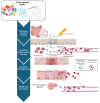Orally Ingested Micro- and Nano-Plastics: A Hidden Driver of Inflammatory Bowel Disease and Colorectal Cancer
- PMID: 39272937
- PMCID: PMC11393928
- DOI: 10.3390/cancers16173079
Orally Ingested Micro- and Nano-Plastics: A Hidden Driver of Inflammatory Bowel Disease and Colorectal Cancer
Abstract
Micro- and nano-plastics (MNPLs) can move along the food chain to higher-level organisms including humans. Three significant routes for MNPLs have been reported: ingestion, inhalation, and dermal contact. Accumulating evidence supports the intestinal toxicity of ingested MNPLs and their role as drivers for increased incidence of colorectal cancer (CRC) in high-risk populations such as inflammatory bowel disease (IBD) patients. However, the mechanisms are largely unknown. In this review, by using the leading scientific publication databases (Web of Science, Google Scholar, Scopus, PubMed, and ScienceDirect), we explored the possible effects and related mechanisms of MNPL exposure on the gut epithelium in healthy conditions and IBD patients. The summarized evidence supports the idea that oral MNPL exposure may contribute to intestinal epithelial damage, thus promoting and sustaining the chronic development of intestinal inflammation, mainly in high-risk populations such as IBD patients. Colonic mucus layer disruption may further facilitate MNPL passage into the bloodstream, thus contributing to the toxic effects of MNPLs on different organ systems and platelet activation, which may, in turn, contribute to the chronic development of inflammation and CRC development. Further exploration of this threat to human health is warranted to reduce potential adverse effects and CRC risk.
Keywords: human exposure; inflammatory bowel diseases; intestinal tumorigenesis; microplastics; nanoplastics; toxicity.
Conflict of interest statement
The authors declare no conflicts of interest.
Figures




References
-
- EFSA CONTAM Panel (EFSA Panel on Contaminants in the Food Chain) Statement on the presence of microplastics and nanoplastics in food, with particular focus on seafood. EFSA J. 2016;14:4501. doi: 10.2903/j.efsa.2016.4501. - DOI
Publication types
Grants and funding
- Award No.ECS00000041/Italian Ministry of University
- No.3277 of 30.12.2021/Next Generation EU -under the National Recovery and Resilience Plan (NRRP), Mission 4 Com-ponent 2 -M4C2, Investment 1.5 - Call for Tender
- Degree No.1057 of 23.06.2022/Project Title: "Innovation, digitalization, and sustainability for the diffused economy in Central It-aly", Concession
LinkOut - more resources
Full Text Sources

